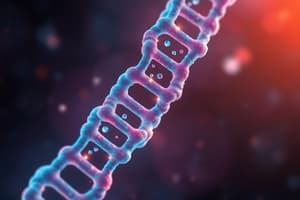Podcast
Questions and Answers
What characterizes polyploidy?
What characterizes polyploidy?
- A chromosome number that is a multiple of the haploid set. (correct)
- An abnormality caused only by anaphase lag.
- Presence of an extra chromosome in a single pair.
- Loss of a chromosome from a homologous pair.
Which of the following types of aberration results from dispermy?
Which of the following types of aberration results from dispermy?
- Balanced Karyotype
- Tetraploidy
- Aneuploidy
- Triploidy (correct)
What is the primary cause of aneuploidy in human embryos?
What is the primary cause of aneuploidy in human embryos?
- Non-disjunction during meiosis I. (correct)
- Normal meiosis without any abnormalities.
- Dispermy occurring during fertilization.
- Failure of cleavage division immediately after fertilization.
How does aneuploidy typically affect the phenotype when it involves autosomes?
How does aneuploidy typically affect the phenotype when it involves autosomes?
Which scenario commonly leads to tetraploidy?
Which scenario commonly leads to tetraploidy?
What is the karyotype notation for a male with Down syndrome?
What is the karyotype notation for a male with Down syndrome?
Which condition is associated with a karyotype of (45, X)?
Which condition is associated with a karyotype of (45, X)?
What best describes the phenomenon of mixoploidy?
What best describes the phenomenon of mixoploidy?
Which of the following statements about Mosaic Down Syndrome is correct?
Which of the following statements about Mosaic Down Syndrome is correct?
What is a consequence of dispermic chimerism?
What is a consequence of dispermic chimerism?
Flashcards
Polyploidy
Polyploidy
A condition where the number of chromosomes is a whole-number multiple of the haploid set.
Aneuploidy
Aneuploidy
An abnormal chromosome number; extra or missing chromosomes, but not a whole set.
Triploidy
Triploidy
A type of polyploidy with three sets of chromosomes.
Non-disjunction
Non-disjunction
Signup and view all the flashcards
Euploidy
Euploidy
Signup and view all the flashcards
Trisomy: What is it?
Trisomy: What is it?
Signup and view all the flashcards
Trisomy Example: Down syndrome
Trisomy Example: Down syndrome
Signup and view all the flashcards
Monosomy: What is it?
Monosomy: What is it?
Signup and view all the flashcards
Monosomy Example: Turner Syndrome
Monosomy Example: Turner Syndrome
Signup and view all the flashcards
Mixoploidy: What is it?
Mixoploidy: What is it?
Signup and view all the flashcards
Study Notes
Chromosomal Aberrations (Numerical & Structural)
- Chromosomal abnormalities involve variations in chromosome number or structure
- Understanding these variations is crucial to interpreting phenotypic outcomes
Numerical Aberrations
-
Euploidy: Normal chromosome number for a species (humans: 46 in somatic cells, 23 in gametes)
-
Polyploidy: Chromosome number is a multiple of the haploid set
- Triploidy: 3 copies of each chromosome (69 chromosomes total). Often results in miscarriage. Can be caused by fertilization of an egg by two sperm (dispermy) or failure in a meiotic division in the egg or sperm.
- Tetraploidy: 4 copies of each chromosome (92 chromosomes total). Extremely rare and almost always lethal, caused by failure of the first zygotic division.
-
Aneuploidy: Abnormal chromosome number due to an extra or missing chromosome, not affecting the entire set of chromosomes
- Trisomy: Presence of three copies of an autosome or sex chromosome (e.g., Down syndrome). The karyotype is described as (47,XY,+21).
- Monosomy: Absence of a single chromosome. Monosomy of an autosome is often incompatible with life. The only known live birth example is Turner syndrome (45, X)
Mixoploidy
- Presence of two or more genetically different cell lineages within one individual
- Mosaicism: Genetically different cells arise from the same zygote
- Chimerism: Fusion of two different zygotes occurs
Structural Aberrations
- Involve chromosome breakage and rejoining in an atypical configuration
- Balanced Rearrangements: Chromosome complement is complete; no loss or gain of genetic material (generally harmless unless a breakpoint affects a critical gene)
- Examples: Inversions, insertions, reciprocal translocations (exchange of segments between non-homologous chromosomes) and Robertsonian translocation (fusion of two acrocentric chromosomes)
- Unbalanced Rearrangements: Chromosome complement has an incorrect amount of material (Often serious clinical consequences)
- Examples: Deletions (loss of chromosomal material), Duplications (extra copies of chromosomal material).
Specific Structural Aberrations
- Deletions: Loss of part of a chromosome. Loss of more than a few percent of the genome is often lethal
- Inversions: A segment of a chromosome is reversed. Balanced rearrangements, usually not harmful unless a breakpoint affects a critical gene.
- Insertions: Insertion of a segment of one chromosome into another.
- Will be balanced if the inserted material has moved from elsewhere in a different chromosome
- Will be unbalanced if the inserted material has come from some other chromosomal location
- Duplications: Extra copies of chromosomal material.
- Translocations: Transfer of genetic material from one chromosome to another. - Reciprocal Translocations: Exchanging segments between non-homologous chromosomes - Robertsonian Translocations: Two acrocentric chromosomes fuse; short arms are often lost, but overall number of chromosomes is decreased
- Isochromosomes: Result from an abnormal centromeric division; consisting of two identical arms (q-arms or p-arms)
- Ring Chromosomes: A chromosome that forms a ring shape due to breaks and rejoining. Often involves loss of material at the ends resulting in potentially serious consequences.
Studying That Suits You
Use AI to generate personalized quizzes and flashcards to suit your learning preferences.




